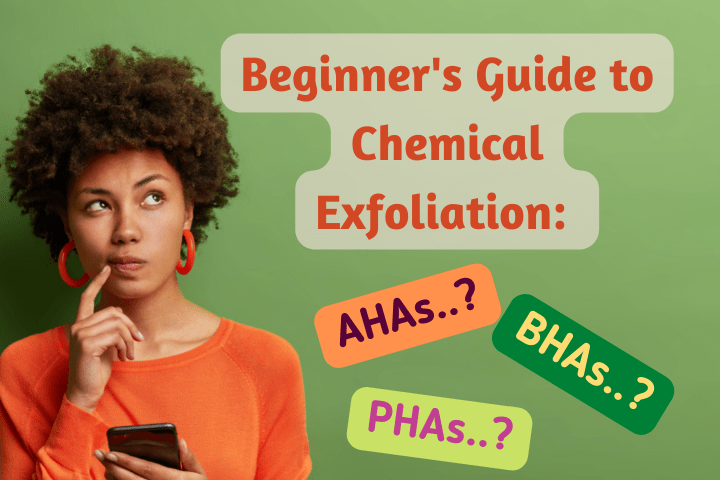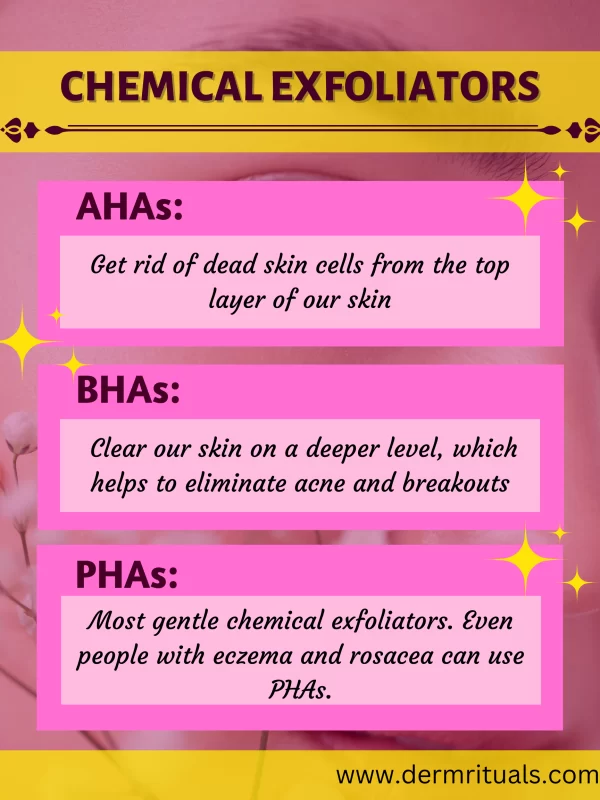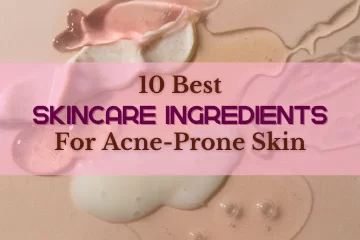Chemical Exfoliation: Beginner’s Guide to AHAs, BHAs & PHAs

Exfoliation is an essential part of our basic skincare routines. It helps our skin get rid of dead skin cells and brightens our skin complexion.
Exfoliation is important for all skin types, but if you have oily and acne-prone skin, it can greatly improve your skin. Exfoliation removes dead skin cells that can cause clogged pores and eventually lead to skin problems.
There are two common types of exfoliation for the skin.
Physical exfoliation Chemical exfoliation
Physical Exfoliation:
Physical exfoliation is done by using scrubs that contain tiny beads. These beads physically scrub your skin and remove excess dirt and dead skin. These beads are usually made of nut shells, other materials are also used.
The only drawback is that they can be harsh on our skin if used too often. Especially people with sensitive skin should avoid physically scrubbing their skin.
Some other types of physical exfoliators are dry brushes, cleansing brushes, towels, etc. I have discussed why I do not like physical exfoliators in the blog post below:
Read This Before Buying Exfoliants
☝️ Check it out if you want more information on exfoliators.
Chemical Exfoliation:
Chemical exfoliation sounds really harsh and confusing especially since the thought of putting acids on our skin can be overwhelming. But, in reality, chemical exfoliators are more efficient and gentler on the skin than physical exfoliators.
Chemical exfoliators are naturally derived from fruits and plants most of the time. They remove dead skin cells without physically scrubbing our skin and give us that extra glow.
Chemical exfoliators un-bind the glue that holds our dead skin together on the epidermis layer, it breaks down the excess buildup of dead skin cells which can cause breakouts and clogged pores.
They also help to increase cell regeneration so our skin looks bright and young for a longer time. These exfoliators even out skin tone and reduce the appearance of freckles and hyper-pigmentation.
Good news…
All skin types can use chemical exfoliators. You just need to choose the right type.
There are 3 types of Chemical Exfoliators:
AHAs
BHAs
PHAs
AHAs:
AHA Stands for Alpha Hydroxy Acid. They are plant-based and water-soluble, which means that they will work on the surface layer of the skin and stay away from oil-based areas like the hairline, nose, and deep inside our pores. There are several types of AHAs you can find in skincare products. Some of the common AHAs are:
Glycolic Acid:
This is the most common AHA that is used in skincare. It is highly effective and potent. Glycolic acid is derived from sugar cane. It has the smallest molecular size compared to other AHAs which is why it penetrates deeper into the skin and is more effective.
Because it penetrates more profoundly, it can cause slight irritation to the skin. So if you are starting out with chemical exfoliators then use a lower percentage (less than 9%)
Lactic Acid:
This is the most suitable form of AHA for sensitive skin. It is derived from sour milk. Lactic acid is a very gentle AHA because it has a larger molecular size so it does not penetrate deep inside the skin.
It can help retain the moisture of our skin because of its humectant properties, protect our skin from bacteria due to anti-microbial properties, and also reduce hyperpigmentation.
Mandelic Acid:
Mandelic acid is derived from bitter almonds and is rich in antioxidants. It also has anti-bacterial properties that can benefit acne-prone and oily skin. Mandelic acid is also great for anti-aging, fine lines and wrinkles.
Malic Acid:
This acid is found in fruits, mostly apples. Malic Acid is found in apple cider vinegar, which is why it is used in so many DIYs for the skin and actually works. Malic acid brightens the skin and tightens the appearance of pores. Again it is good for anti-aging fine lines and wrinkles.
Citric Acid:
As its name suggests, Citric acid is derived from citrus fruits like oranges, limes, etc. Citric acid helps to brighten up and to regulate the PH levels of our skin.
Also, it can be used as a preservative in skincare products. It has anti-aging and anti-inflammatory properties as well. Like how you squeeze a lemon on an apple to stop it from turning brown… Citric Acid 😉
Tartaric Acid:
This is not a very common AHA as there is a lot more to be researched about it, but so far we know that Tartaric acid is derived from grapes. It is rich in antioxidants and has healing properties. It also helps to moisturize the skin.
Moving on to…
BHAs:
BHA stands for Beta Hydroxy Acid. These are oil-soluble acids which means they are oil-based so they can reach to oiliest parts of our skin and can penetrate deep into our skin layer.
BHAs go deep in our skin and are able to soak up access sebum and dirt from within our pores. They clear our skin on a deeper level, which helps to eliminate acne and breakouts.
BHAs also calm down inflammation and reduce the appearance of pores. The most commonly used BHA is salicylic acid.
Salicylic Acid:
This is the most common BHA. You can find it in many skincare products. Salicylic acid has anti-inflammatory properties. It’s getting popular because of how beneficial it is for acne-prone and oily skin.
Salicylic acid is the main ingredient in mostly all acne spot treatments available.
Salicylic acid can decrease the production of sebum, which therefore controls oily skin and reduces breakouts overall.
Betane Salicylate:
This is another common BHA that is derived from sugar beets. Betane Salicylate is considered an alternative to Salicylic Acid, especially in countries where Salicylic Acid is banned.
Lipo Hydroxy Acid:
This type of BHA is not very common. It has exfoliating and acne-treating properties. Lipo hydroxy acid has a larger molecular size that makes it beneficial for sensitive skin.
Now, on to PHAs…
PHAs:
PHA stands for Poly Hydroxy Acid. PHAs are considered as next generation of AHAs. PHAs work on the upper layer of skin like AHAs and smooth out skin texture but unlike AHAs, PHAs have larger molecular sizes.
Therefore PHAs are great for people with sensitive skin as they are the most gentle chemical exfoliators. Even people with eczema and rosacea can use PHAs.
PHAs are derived from fruits and also provide protection from sun damage and free-radical damage. The best part is that, unlike other chemical exfoliators, PHAs don’t increase your skin’s sun sensitivity or vulnerability to sun damage.
In my opinion. If you have not used a chemical exfoliator before, start with PHAs.
Some common questions people have about chemical exfoliators are:
Will my face burn off if I use chemical exfoliating acids?
Certainly not, Chemical exfoliation will cause some tingling but it will not have a burning feeling unless you apply it on broken or injured skin. Your skin will get used to the slight tingling feeling after a while.
How do chemical exfoliators work?
Chemical exfoliators work by getting rid of dead skin cells and accessing sebum from our skin. As a result, we have glowing, smooth, and acne-free skin.
Can I mix chemical exfoliators with my other skincare?
Try to use chemical exfoliators with soothing ingredients like niacinamide, hyaluronic acid, centella, tea tree, etc.
How much chemical exfoliation is too much?
Always start with a patch test first. You should use AHAs and BHAs once a week. You can use PHAs daily but people with sensitive skin should use them once a week.
What is the best chemical exfoliator for my skin type?
For oily and acne-prone skin ____ BHAs
For normal skin ____ AHAs
For sensitive, dry skin ____ PHAs
So that’s all for chemical exfoliation for beginners…
To Conclude:
-I hope chemical exfoliators make more sense now. There is no right or wrong to it. We just need to understand:
🔴The potency
🔴Understand the purpose of certain ingredients
🔴Other ingredients that support its functions
– Chemical exfoliators can be used daily, but to begin with, them, start using them once a week and slowly build your tolerance.
– Love yourself and take good care of yourself from the inside and out 🤗



